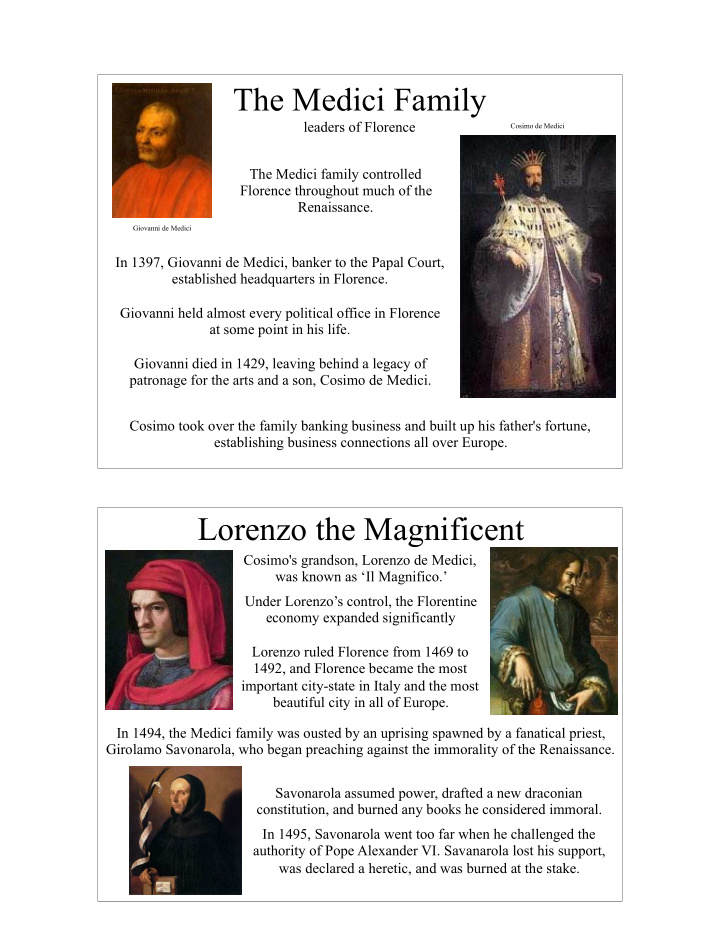



The Medici Family leaders of Florence Cosimo de Medici The Medici family controlled Florence throughout much of the Renaissance. Giovanni de Medici In 1397, Giovanni de Medici, banker to the Papal Court, established headquarters in Florence. Giovanni held almost every political office in Florence at some point in his life. Giovanni died in 1429, leaving behind a legacy of patronage for the arts and a son, Cosimo de Medici. Cosimo took over the family banking business and built up his father's fortune, establishing business connections all over Europe. Lorenzo the Magnificent Cosimo's grandson, Lorenzo de Medici, was known as ‘Il Magnifico.’ Under Lorenzo’s control, the Florentine economy expanded significantly Lorenzo ruled Florence from 1469 to 1492, and Florence became the most important city-state in Italy and the most beautiful city in all of Europe. In 1494, the Medici family was ousted by an uprising spawned by a fanatical priest, Girolamo Savonarola, who began preaching against the immorality of the Renaissance. Savonarola assumed power, drafted a new draconian constitution, and burned any books he considered immoral. In 1495, Savonarola went too far when he challenged the authority of Pope Alexander VI. Savanarola lost his support, was declared a heretic, and was burned at the stake.
Niccolò Machiavelli In 1502 Niccolò Machiavelli was appointed as political adviser and protégé to Piero Soderini, elected chief magistrate for life of Florence. Soderini’s soon surrendered to the attacking Medici, however, signaling the end of Machiavelli’s dreams of political greatness. Machiavelli then asked for a job with Giovanni de Medici’s new regime, but instead, the Medici sent him into solitary exile. While in exile Machiavelli composed The Prince, a manifesto which came to symbolize a new breed of politics that was shrewd but without morality. He remained in exile for the rest of his life. His legacy was his name and his manifesto. “Since love and fear can hardly exist together, if we must choose between them, it is far safer to be feared than loved…” “I see that one is obliged to look to the results of an action, and not to the means by which it was achieved…” “The fortunate man is he who fits his plan of action to the times.” The Renaissance Papacy The Renaissance popes were known for their sponsorship of the arts and their political machinations, but not for their theology, morality, or spirituality. These popes became both religious and secular rulers, signing treaties with other sovereigns and fighting wars. They used the papal military to enforce and expand upon the longstanding territorial and property claims of the papacy. With ambitious expenditures on war and construction projects, popes turned to new sources of revenue from the sale of indulgences and bureaucratic and ecclesiastical offices. The popes became absolute monarchs but unlike their European peers, they were not hereditary, so they could only promote their family interests through nepotism. (The word nepotism originally referred specifically to the practice of creating cardinal-nephews; it appeared in the English language about 1669.)
Renaissance Popes Good and, well... Nicholas V (1447-1455) was best-known for the rebuilding of St. Peter's Basilica, which began during his reign. Julius II (1503-1513) commissioned Michelangelo to decorate the Sistine Chapel. He also become known as “the Warrior Pope” for his use of bloodshed to increase the territory and property of the papacy. Leo X (1513-21) was said to have remarked: “Let us enjoy the papacy, since God has given it to us.” The diplomatic and military campaigns of Pope Clement VII (1523-1534) resulted in the Sack of Rome in 1527. Alexander VI (1492-1503) had four acknowledged children. Men and Women of the Italian Renaissance Research Guidelines You will conduct some research about a specific Renaissance-Era man or woman and then use this research to create a biographical chart and Bio Poem about this individual. Step 1: Create a biographical chart about this individual, including: name dates and places of birth and death contributions to the Renaissance (1-2 of the major contributions) other significant life events (“you need to know this” information) at least one “fun fact” – cool info that would impress your friends (be sure to keep citations for the sources used in your research)* Step 2: Create a poem about this individual, following this format: Line 1: the individual’s first name Line 2: 4-5 adjectives that describe the individual Line 3: one important relationship in the individual’s life Line 4: 2-3 things, people, or ideas the individual loved Line 5: accomplishments of the individual Line 6: the individual’s residence (name of city/town or name of home) Line 7: the individual’s last name Step 3: Type both the biographical chart (with citations) and the Bio Poem. The individual I will be researching is: ____________________________________________________
Recommend
More recommend